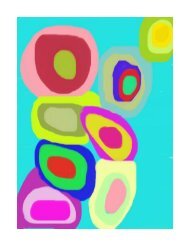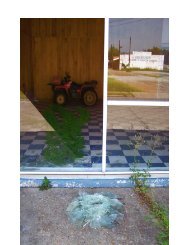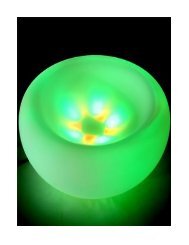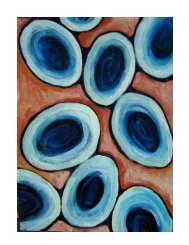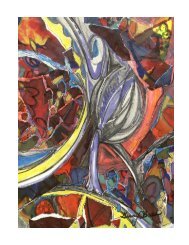Commentaries on Bob Cobbing - The Argotist Online
Commentaries on Bob Cobbing - The Argotist Online
Commentaries on Bob Cobbing - The Argotist Online
Create successful ePaper yourself
Turn your PDF publications into a flip-book with our unique Google optimized e-Paper software.
Comparing it with specific painters would mislead us and likely demean <strong>Cobbing</strong>’s work; but some<br />
ignorant types have made comparis<strong>on</strong>s with Pollock: any comparis<strong>on</strong> to Pollock, except perhaps in<br />
the idiosyncratic difference to almost everything else that has been d<strong>on</strong>e, would be misleading.<br />
<strong>Cobbing</strong> liked Pollock’s painting; but that’s something else.<br />
One needs to look carelessly to think that it’s like Pollock. In <strong>Cobbing</strong>’s work, the image has been<br />
placed carefully in all its parts and the means of delivering it to the carrier paper has been<br />
mechanically c<strong>on</strong>trolled at a remove.<br />
<strong>The</strong> process of the reproducti<strong>on</strong> of the poem has its own method within the generic method of<br />
ink-duplicati<strong>on</strong>.<br />
It’s not the layering of pigment that you get with, say, Auerbach. <strong>The</strong> ink would never dry! It’s of a<br />
different kind. <strong>The</strong> blackness of these pages stands out because it is so unexpected and perhaps<br />
because many of us know it is so difficult to achieve. He pushed the duplicator bey<strong>on</strong>d its intended<br />
capabilities by a l<strong>on</strong>g way.<br />
It isn’t just putting more and more colour <strong>on</strong>. It may feel that the ink is thickly applied as <strong>on</strong>e looks<br />
at it, but actually it isn’t like that. <strong>The</strong>re is <strong>on</strong>ly <strong>on</strong>e applicati<strong>on</strong> here, <strong>on</strong>e pass through the<br />
machine.<br />
<strong>The</strong>re may be a c<strong>on</strong>necti<strong>on</strong> here with his often repeated Cagean advice that if a performance<br />
wasn’t working then <strong>on</strong>e kept going till it did. Not that I suggest that this poem didn’t work at an<br />
earlier stage. I mean that there is a point or points, extremes to some maybe, at which the poem<br />
works; it may be difficult to access that point; but <strong>on</strong>e just sticks to it till <strong>on</strong>e gets there.<br />
He did put the paper through the machine twice <strong>on</strong> some occasi<strong>on</strong>s. He did that in Winter Poem 1<br />
where, it seems he judged, the <strong>on</strong>ly way to get two quite different effects of very light ink output<br />
and very heavy ink output in much the same space was to use two different stencils. Note,<br />
therefore, that he knew where the apparently impossible became actually impossible; and he had<br />
a way round it.<br />
It is, of course, for that reas<strong>on</strong> that each image copy made by <strong>Cobbing</strong> was slightly different to all<br />
the others, because registrati<strong>on</strong> is not the ink duplicator’s str<strong>on</strong>gest point.<br />
Thus, <strong>on</strong>e could not use this fix in every situati<strong>on</strong>. Mixing n<strong>on</strong>-alphabetic image and text would be<br />
difficult to handle with a misregistering printing machine; so that, as Mottram noted the<br />
appropriateness of design to the c<strong>on</strong>tents of Writers Forum publicati<strong>on</strong>s, printing techniques were<br />
also applied as appropriate. Simply put, <strong>Cobbing</strong> knew what he was doing; it was just that he was<br />
doing things few people had thought of. And he didn’t say what he was doing. Instead he urged you<br />
to read the products attentively. That makes more sense. He wanted people to enjoy the outputs,<br />
rather than write about them, copying quotes from him, without engaged understanding.<br />
Look at the blackness of these pages; and remember that the title is Lights<strong>on</strong>g 2. Where’s the light?<br />
Is it the white or is it the black? I’d say it’s both. I’d say that as a text for reading he would have<br />
been reading the differences, the changes, the c<strong>on</strong>versati<strong>on</strong> between the background of the paper



